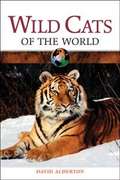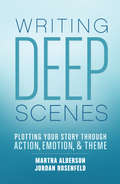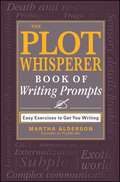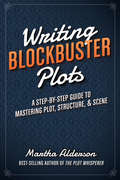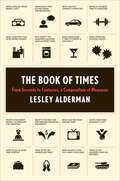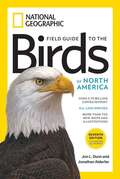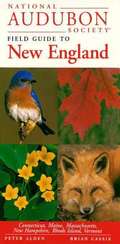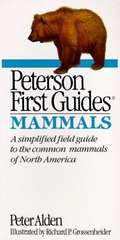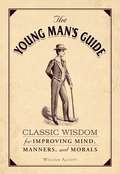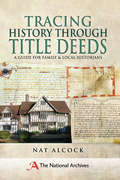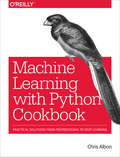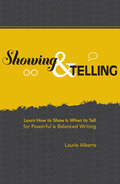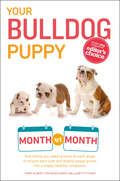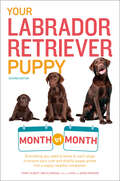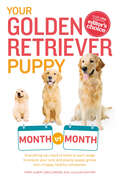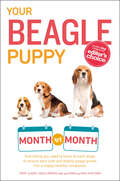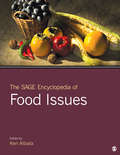- Table View
- List View
Encyclopedia of Dogs
by David AldertonDogs have been our closest animal companions since before the start of recorded history. They have traveled with us, fought with us, and saved countless lives. As society has changed over the course of millennia, so have dogs--a trend that is still apparent today, with dogs being kept increasingly for companionship rather than for working purposes. There is no universal system of breed classification for dogs but, generally, they are divided on the basis of their original function. Some categories such as the hound group are more natural than others, which may simply consist of breeds with diverse working ancestries. Not all breeds are recognized for show purposes, and recognition can vary between different organizations and countries.
Wild Cats of the World
by David AldertonThis text explores the world of cats. It traces the evolution, distribution, and current status of cats from Africa to the Americas. Each species is discussed in detail, and information on distinctive features such as sight, hearing, hunting techniques, and locomotion is provided.
Writing Deep Scenes: Plotting Your Story Through Action, Emotion, and Theme
by Martha Alderson Jordan RosenfeldTake a Deep Dive into Plot and Scene and Improve Your WritingWhether you're planning your first novel or have already written a first draft, you need to master the concepts of plot and scene to truly realize your story's potential. Writing Deep Scenes teaches you how to write strong, layered, and engaging scenes--the secret to memorable, page-turning plots. It's filled with practical tools for building layers and nuance into your scenes, employing the right scene types at the right junctures, and developing a profound understanding of how plot and scene intertwine.Inside you'll learn:How scenes are comprised of three key layers: action, emotion, and theme.How to recognize each layer and weave them seamlessly into a scene.How to develop an intricate relationship between the action and emotion in every scene.How thematic imagery embedded in scenes increases a story's tension and contributes to the story's meaning.Using contemporary examples from a variety of genres, Writing Deep Scenes provides an effective method for plotting at the scene level. Use these techniques and enrich your fiction and memoirs with page-turning suspense and pathos, and explore new depths in every story you write.
The Plot Whisperer Book of Writing Prompts
by Martha AldersonDaily exercises guaranteed to spark your writing! The Plot Whisperer Book of Writing Prompts gives you the inspiration and motivation you need to finish every one of your writing projects. Written by celebrated writing teacher and author Martha Alderson, this book guides you through each stage of the writing process, from constructing compelling characters to establishing an unforgettable ending. Alderson also helps you get into the habit of writing creatively every day, with brand-new imaginative prompts, such as: Create an obstacle that interferes with the protagonist's goal and describe how that scene unfolds moment-by-moment. Provide sensory details of the story world and what your main character is doing at this very moment. Scan earlier scenes for examples of the protagonist's chief character flaw and develop it. He or she will need to overcome this flaw in order to achieve his or her ultimate goal. Show an issue or situation in the main character's life that needs attention and have him or her take the first step forward toward a course of action. Filled with daily affirmations, plot advice, and writing exercises, The Plot Whisperer Book of Writing Prompts will set your projects in the right direction--and on their way to the bestseller list!
The Plot Whisperer Book of Writing Prompts: Easy Exercises to Get You Writing
by Martha AldersonDaily exercises guaranteed to spark your writing!The Plot Whisperer Book of Writing Prompts gives you the inspiration and motivation you need to finish every one of your writing projects. Written by celebrated writing teacher and author Martha Alderson, this book guides you through each stage of the writing process, from constructing compelling characters to establishing an unforgettable ending. Alderson also helps you get into the habit of writing creatively every day, with brand-new imaginative prompts, such as:Create an obstacle that interferes with the protagonist's goal and describe how that scene unfolds moment-by-moment.Provide sensory details of the story world and what your main character is doing at this very moment.Scan earlier scenes for examples of the protagonist's chief character flaw and develop it. He or she will need to overcome this flaw in order to achieve his or her ultimate goal.Show an issue or situation in the main character's life that needs attention and have him or her take the first step forward toward a course of action.Filled with daily affirmations, plot advice, and writing exercises, The Plot Whisperer Book of Writing Prompts will set your projects in the right direction--and on their way to the bestseller list!
The Plot Whisperer Book of Writing Prompts
by Martha AldersonDaily exercises guaranteed to spark your writing! The Plot Whisperer Book of Writing Prompts gives you the inspiration and motivation you need to finish every one of your writing projects. Written by celebrated writing teacher and author Martha Alderson, this book guides you through each stage of the writing process, from constructing compelling characters to establishing an unforgettable ending. Alderson also helps you get into the habit of writing creatively every day, with brand-new imaginative prompts, such as: Create an obstacle that interferes with the protagonist's goal and describe how that scene unfolds moment-by-moment. Provide sensory details of the story world and what your main character is doing at this very moment. Scan earlier scenes for examples of the protagonist's chief character flaw and develop it. He or she will need to overcome this flaw in order to achieve his or her ultimate goal. Show an issue or situation in the main character's life that needs attention and have him or her take the first step forward toward a course of action. Filled with daily affirmations, plot advice, and writing exercises, The Plot Whisperer Book of Writing Prompts will set your projects in the right direction--and on their way to the bestseller list!
Writing Blockbuster Plots: A Step-by-Step Guide to Mastering Plot, Structure, and Scene
by Martha AldersonPlotting a story filled with memorable, engaging scenes from beginning to end can feel like an insurmountable challenge. Having the right plan - and the tools to execute it - can make all the difference. Writing Blockbuster Plots pulls back the curtain on story structure with step-by-step strategies and visuals that turn plotting and scene writing into a no-stress endeavor.In this completely revised and updated edition, celebrated writing instructor and plot consultant Martha Alderson helps you navigate the intricacies of story with the help of her exclusive Plot Planner and Scene Tracker tools. Using Alderson's effective, accessible techniques, you'll be able to:PLOT your story from beginning to end with a focus on dramatic action, the emotional development of your characters, and thematic significance.ENSURE that each scene contributes meaningfully to the narrative by tracking the seven essential elements of scene.LINK scenes by cause and effect to create a tight, seamless narrative.INJECT tension and conflict to keep readers glued to the page.TARGET weak areas in your story and learn how to fix them.Filled with examples from both classic and contemporary novels, as well as illustrations of the Plot Planner and Scene Tracker in action, Writing Blockbuster Plots strips the confusion out of the plotting process, enabling you to write a story that deserves a standing ovation.
The Book of Times: From Seconds to Centuries, a Compendium of Measures
by Lesley AldermanAn endlessly fascinating, beautifully designed survey of time—how long things take, how long things last, and how we spend our daysOur relationship to time is complex and paradoxical: Time stands still. Time also flies. Tomorrow is another day. Yet there's no time like the present. We want to do more in less time, but wish we could slow the clock. And despite all our time-saving devices—iPhones, DVRs, high-speed trains—Americans feel that they have less leisure time than ever.In an era when our time feels fractured and imperiled, The Book of Times encourages readers to ponder time used and time spent. How long does it take to find a new mate, digest a hamburger, or compose a symphony? How much time do we spend daydreaming, texting, and getting ready for work? The book challenges our beliefs and urges us to consider how, and why, some things get faster, some things slow down, and some things never change (the need for seven to eight hours of sleep).Packed with compelling charts, lists, and quizzes, as well as new and intriguing research, The Book of Times is an addictive, browsable, and provocative look at the idea of time from every direction.
National Geographic Field Guide To The Birds Of North America, 7th Edition
by Jonathan AlderferThis fully revised edition of the best-selling North American bird field guide is the most up-to-date guide on the market. Perfect for beginning to advanced birders, it is the only book organized to match the latest American Ornithological Society taxonomy. With more than 2.75 million copies in print, this perennial bestseller is the most frequently updated of all North American bird field guides. Filled with hand-painted illustrations from top nature artists (including the ever-popular hummingbird), this latest edition is poised to become an instant must-have for every serious birder in the United States and Canada. The 7th edition includes 37 new species for a total of 1,023 species; 16 new pages allow for 250 fresh illustrations; 80 new maps; and 350 map revisions. With taxonomy revised to reflect the radical new American Ornithological Society taxonomy established in 2016, the addition of standardized banding codes, and text completely vetted by birding experts, this new edition will top of the list of birding field guides for years to come.
The Inherent Right of Self-Defence in International Law
by Murray Colin AlderDetermining the earliest point in time at which international law authorises a state to exercise its inherent right of self-defence is an issue which has been debated, but unsatisfactorily reasoned, by scholars and states since the 1960's. Yet it remains arguably the most pressing question of law that faces the international community. This book unravels the legal and factual complications which have obscured the answer to this question. In contrast to most other works, it takes an historic approach by tracing the evolution of the rights, rules and principles of international law which have governed the use of force by states since the 16th century. Its emphasis on self-defence provides the reader with a new and complete understanding of how and why the international legal framework limits defensive force to repelling an imminent threat or use of offensive force which is directed at the territory of a state. Taking an historic approach enables this book to resurrect an understanding of the human defensive instinct which has guided the formation of the international law of self-defence. It also explains the true legal nature and scope of the inherent right of self-defence, of anticipatory self-defence and provides a definition of the legal commencement of an armed attack for the purpose of Article 51 of the Charter. Finally, the reader will receive a unique source of research materials and analysis of state practice and of scholarly works concerning self-defence and the use of force since the 16th century, which is suitable for all readers of international law around the world.
National Audubon Society Regional Guide To New England
by Peter Alden National Audubon Society StaffFilled with concise descriptions and stunning photographs, the National Audubon Society Field Guide to New England belongs in the home of every New England resident and in the suitcase or backpack of every visitor. This compact volume contains: An easy-to-use field guide for identifying 1,000 of the region's wildflowers, trees, mushrooms, mosses, fishes, amphibians, reptiles, birds, butterflies, mammals, and much more; A complete overview of New England's natural history, covering geology, wildlife habitats, ecology, fossils, rocks and minerals, clouds and weather patterns and night sky; An extensive sampling of the area's best parks, preserves, beaches, forests, islands, and wildlife sanctuaries, with detailed descriptions and visitor information for 50 sites and notes on dozens of others. The guide is packed with visual information -- the 1,500 full-color images include more than 1,300 photographs, 14 maps, and 16 night-sky charts, as well as 150 drawings explaining everything from geological processes to the basic features of different plants and animals. For everyone who lives or spends time in Connecticut, Maine, Massachusetts, Rhode Island, New Hampshire, or Vermont, there can be no finer guide to the area's natural surroundings than the National Audubon Society Field Guide to New England.
Peterson First Guide to Mammals of North America
by Peter AldenIntended for children and teens, this book is a guide to marsupials, insectivores, bats, carnivores, seals, rodents, rabbits, hoofed animals, edentates, sirenians, and whales.
Understanding Immigration Law
by Raquel AldanaUnderstanding Immigration Law lays out the basics of U. S. immigration law in an accessible way to newcomers to the field. It offers background about the intellectual, historical, and constitutional foundations of U. S. immigration law. The book also identifies the factors that have historically fueled migration to the United States, including the economic pull of jobs and family in the United States and the push of economic hardship, political instability, and other facts of life in the sending country. In the middle chapters, the authors provide a capsule summary of the law concerning the admissions and removal procedures and criteria in the Immigration and Nationality Act. The book ends with a chapter speculating about the future of U. S. immigration law and the challenges and opportunities facing the nation.
The Young Man's Guide
by William AlcottTimeless wisdom for the modern man! In the nineteenth century, William Alcott's The Young Man's Guide paved the way toward personal and financial success for thousands of men. Now, in this unique rendition of his classic work, you, too, can use his wisdom to unlock your greatest potential and live a happy and prosperous life. From refining your appearance and handling social interactions to managing your finances and business matters, each of the aphorisms and quotes in this book reveals simple yet revelatory techniques that will empower you to redefine your future and fill it with love, joy, and abundance. With William Alcott's guidance, you will strengthen your character, harness purposeful thoughts, and create the life you've always wanted.
The Young Man's Guide: Classic Wisdom for Improving Mind, Manners, and Morals
by William AlcottTimeless wisdom for the modern man!In the nineteenth century, William Alcott'sThe Young Man's Guide paved the way toward personal and financial success for thousands of men. Now, in this unique rendition of his classic work, you, too, can use his wisdom to unlock your greatest potential and live a happy and prosperous life. From refining your appearance and handling social interactions to managing your finances and business matters, each of the aphorisms and quotes in this book reveals simple yet revelatory techniques that will empower you to redefine your future and fill it with love, joy, and abundance.With William Alcott's guidance, you will strengthen your character, harness purposeful thoughts, and create the life you've always wanted.
Tracing History Through Title Deeds: A Guide for Family & Local Historians
by Nat AlcockProperty title deeds are perhaps the most numerous sources of historical evidence but also one of the most neglected. While the information any one deed contains can often be reduced to a few lines, it can be of critical importance for family and local historians. Nat Alcock's handbook aims to help the growing army of enthusiastic researchers to use the evidence of these documents, without burying them in legal technicalities. It also reveals how fascinating and rewarding they can be once their history, language and purpose are understood. A sequence of concise, accessible chapters explains why they are so useful, where they can be found and how the evidence they provide can be extracted and applied. Family historians will find they reveal family, social and financial relationships and local historians can discover from them so much about land ownership, field and place names, the history of buildings and the expansion of towns and cities. They also bring our ancestors into view in the fullness of life, not just at birth, marriage and death, and provide more rounded pictures of the members of a family tree.
Machine Learning with Python Cookbook: Practical Solutions from Preprocessing to Deep Learning
by Chris AlbonThis practical guide provides nearly 200 self-contained recipes to help you solve machine learning challenges you may encounter in your daily work. If you’re comfortable with Python and its libraries, including pandas and scikit-learn, you’ll be able to address specific problems such as loading data, handling text or numerical data, model selection, and dimensionality reduction and many other topics.Each recipe includes code that you can copy and paste into a toy dataset to ensure that it actually works. From there, you can insert, combine, or adapt the code to help construct your application. Recipes also include a discussion that explains the solution and provides meaningful context. This cookbook takes you beyond theory and concepts by providing the nuts and bolts you need to construct working machine learning applications.You’ll find recipes for:Vectors, matrices, and arraysHandling numerical and categorical data, text, images, and dates and timesDimensionality reduction using feature extraction or feature selectionModel evaluation and selectionLinear and logical regression, trees and forests, and k-nearest neighborsSupport vector machines (SVM), naïve Bayes, clustering, and neural networksSaving and loading trained models
Showing & Telling: Learn How to Show & When to Tell for Powerful & Balanced Writing
by Laurie AlbertsWrite vibrant scenes and essential summaries "Show#151;don't tell. " How many times have you heard this standard bit of writing advice? It's so common in writing courses and critiques that it has become a cliche. Writers are often told to write scenes, dramatize, cut exposition, cut summary#151;but it's misguided advice. The truth is good writing almost always requires both showing and telling. The trick is finding the right balance of scene and summary#151;the two basic components of creative prose. Showing and Tellingshows you how to employ each of these essential techniques in the appropriate places within a narrative. You'll learn how to: Write scenes and cut exposition Compress time and summarize background information Create graceful transitions Effectively inject interpretation And more! Complete with examples from bestsellers and interactive exercises, this comprehensive guide offers an in-depth look at scene development, the role of reflection in storytelling, the art of summarizing, and how to bring it all together.
Your Bulldog Puppy Month by Month: Everything You Need to Know at Each Stage to Ensure Your Cute and Playful Puppy (Your Puppy Month by Month)
by Terry Albert Tom Geiselhardt Betty FisherYour Bulldog Puppy Month by Month, written by a veterinarian, a trainer, and a breeder team, provides readers with everything they need to know and do at each stage of development to make sure their playful, energetic puppy grows into a happy, healthy, and well-adjusted companion. Coverage includes: • Information on what to ask the breeder before bringing your puppy home, the necessary vaccinations your puppy needs and when to get them, and when a trip to the vet is needed. • Instructions on making potty training as smooth (and quick) as possible. • Discussion on why and how to crate train and what to do when your puppy cries at night. • Knowing when to teach your puppy is ready to learn basic commands and how to go about leash training. • Socialization: why it's necessary, when it should happen, and how to make sure it does. • Exercising and feeding your puppy appropriately to ensure he stays physically and mentally healthy. • When your puppy is ready for obedience training and how to make sure it works. • How and how often to bathe your puppy, brush his coat, clip his nails, and brush his teeth. • What causes problem behaviors, when to expect them, and how to correct them.
Your Labrador Retriever Puppy Month by Month, 2nd Edition: Everything You Need to Know at Each Stage of Development (Your Puppy Month by Month)
by Terry Albert Debra Eldredge Don Ironside Barb IronsideYour Labrador Retriever Puppy Month by Month, Second Edition, provides new puppy owners with everything you need to know and do at each stage of development to make sure your playful, energetic puppy grows into a happy, healthy, and well-adjusted companion. Expert authors Terry Albert, vet Deb Eldredge, and breeder Joanne Olivier team up to cover all the questions new owners tend to have and may not think to ask, including: • What to ask the breeder before bringing your puppy home. • Which vaccinations your puppy needs and when to get them. • How to make potty training as smooth (and quick) as possible. • What do to when your puppy cries at night. • Why and how to crate train your puppy. • When socialization should happen and how to make sure it does. • When your puppy is ready to learn basic commands—like Sit, Stay, and Come—and the best way to teach them. • When and how to go about leash training. • How much exercise your puppy needs to stay physically and mentally healthy. • What, how much, and when to feed your puppy to give him the nutrition he needs without the extra weight he doesn&’t. • When your puppy is ready for obedience training and how to make sure it works. • How and how often to bath your puppy, brush his coat, clip his nails, and brush his teeth. • How to know what requires a trip to the vet and what doesn't. • What causes problem behaviors, when to expect them, and how to correct them.
Your Golden Retriever Puppy Month by Month: Everything You Need to Know at Each Stage to Ensure Your Cute and Playful Puppy (Your Puppy Month by Month)
by Terry Albert Debra Eldredge Alan GuntherYour Golden Retriever Puppy Month by Month provides new pet owners with everything you need to know and do at each stage of development to make sure your playful, energetic puppy grows into a happy, healthy, and well-adjusted companion. A veterinarian, a trainer, and a breeder team up to cover all the questions new owners tend to have, and many they don&’t think to ask, including: * What to ask the breeder before bringing your puppy home. * Which vaccinations your puppy needs and when to get them. * How to make potty training as smooth (and quick) as possible. * What to do when your puppy cries at night. * Why and how to crate train your puppy. * When socialization should happen and how to make sure it does. * When your puppy is ready to learn basic commands—like Sit, Stay, and Come—and the best way to teach them. * When and how to go about leash training. * How much exercise your puppy needs to stay physically and mentally healthy. * What, how much, and when to feed your puppy to give him the nutrition he needs without the extra weight he doesn&’t. * When your puppy is ready for obedience training and how to make sure it works. * How and how often to bathe your puppy, brush his coat, clip his nails, and brush his teeth. * How to know when a trip to the vet is needed. * What causes problem behaviors, when to expect them, and how to correct them.
Your Beagle Puppy Month by Month: Everything You Need to Know at Each State to Ensure Your Cute and Playful Puppy (Your Puppy Month by Month)
by Terry AlbertYour Beagle Puppy Month by Month, written by a veterinarian, a trainer, and a breeder team, provides readers with everything they need to know and do at each stage of development to make sure their playful, energetic puppy grows into a happy, healthy, and well-adjusted companion. Coverage includes information on what to ask the breeder before bringing your puppy home, the necessary vaccinations your puppy needs and when to get them, and when a trip to the vet is needed. Also included: • Instructions on making potty training as smooth (and quick) as possible. • Discussion on why and how to crate train and what to do when your puppy cries at night. • Knowing when to teach your puppy is ready to learn basic commands and how to go about leash training. • Socialization: why it's necessary, when it should happen, and how to make sure it does. • Exercising and feeding your puppy appropriately to ensure he stays physically and mentally healthy. • When your puppy is ready for obedience training and how to make sure it works. • How and how often to bathe your puppy, brush his coat, clip his nails, and brush his teeth. • What causes problem behaviors, when to expect them, and how to correct them.
The SAGE Encyclopedia of Food Issues
by Ken AlbalaThe SAGE Encyclopedia of Food Issues explores the topic of food across multiple disciplines within the social sciences and related areas including business, consumerism, marketing, and environmentalism. In contrast to the existing reference works on the topic of food that tend to fall into the categories of cultural perspectives, this carefully balanced academic encyclopedia focuses on social and policy aspects of food production, safety, regulation, labeling, marketing, distribution, and consumption. A sampling of general topic areas covered includes Agriculture, Labor, Food Processing, Marketing and Advertising, Trade and Distribution, Retail and Shopping, Consumption, Food Ideologies, Food in Popular Media, Food Safety, Environment, Health, Government Policy, and Hunger and Poverty. This encyclopedia introduces students to the fascinating, and at times contentious, and ever-so-vital field involving food issues. Key Features: Contains approximately 500 signed entries concluding with cross-references and suggestions for further readings Organized A-to-Z with a thematic “Reader’s Guide” in the front matter grouping related entries by general topic area Provides a Resource Guide and a detailed and comprehensive Index along with robust search-and-browse functionality in the electronic edition This three-volume reference work will serve as a general, non-technical resource for students and researchers who seek to better understand the topic of food and the issues surrounding it.
The SAGE Encyclopedia of Food Issues
by Ken AlbalaThe SAGE Encyclopedia of Food Issues explores the topic of food across multiple disciplines within the social sciences and related areas including business, consumerism, marketing, and environmentalism. In contrast to the existing reference works on the topic of food that tend to fall into the categories of cultural perspectives, this carefully balanced academic encyclopedia focuses on social and policy aspects of food production, safety, regulation, labeling, marketing, distribution, and consumption. A sampling of general topic areas covered includes Agriculture, Labor, Food Processing, Marketing and Advertising, Trade and Distribution, Retail and Shopping, Consumption, Food Ideologies, Food in Popular Media, Food Safety, Environment, Health, Government Policy, and Hunger and Poverty. This encyclopedia introduces students to the fascinating, and at times contentious, and ever-so-vital field involving food issues. Key Features: Contains approximately 500 signed entries concluding with cross-references and suggestions for further readings Organized A-to-Z with a thematic “Reader’s Guide” in the front matter grouping related entries by general topic area Provides a Resource Guide and a detailed and comprehensive Index along with robust search-and-browse functionality in the electronic edition This three-volume reference work will serve as a general, non-technical resource for students and researchers who seek to better understand the topic of food and the issues surrounding it.
Arabic Thought and Islamic Societies (Routledge Library Editions: Politics of Islam)
by Aziz Al-AzmehThis is a study of the structure and composition of the official learning current in medieval Arabic culture. This comprises natural sciences both exoteric and esoteric (medicine, alchemy, astrology and others), traditional and religious sciences (such as theology, exegesis and grammar), philosophical sciences such as metaphysics and ethics, in addition to technical disciplines like political theory and medicine, and other fields of intellectual endeavour. The book identifies and develops a number of conceptual elements common to the various areas of official Arabic scientific discourse, and shows how these elements integrate these disparate sciences into an historical epistemic unity. The specific profile of each of these different sciences is described, in terms of its conceptual content, but especially with reference to its historical circumstances. These are seen to be embodied in a number of institutional supports, both intellectual and social: paradigms, schools of thought, institutions of learning, pedagogic techniques, and a body of professionals, all of which combine to form definite, albeit ever renewed, traditions of learning. Finally, an attempt is made to relate Arabic scientific knowledge in the Middle Ages to patterns of scientific and political authority. First published in 1986.

